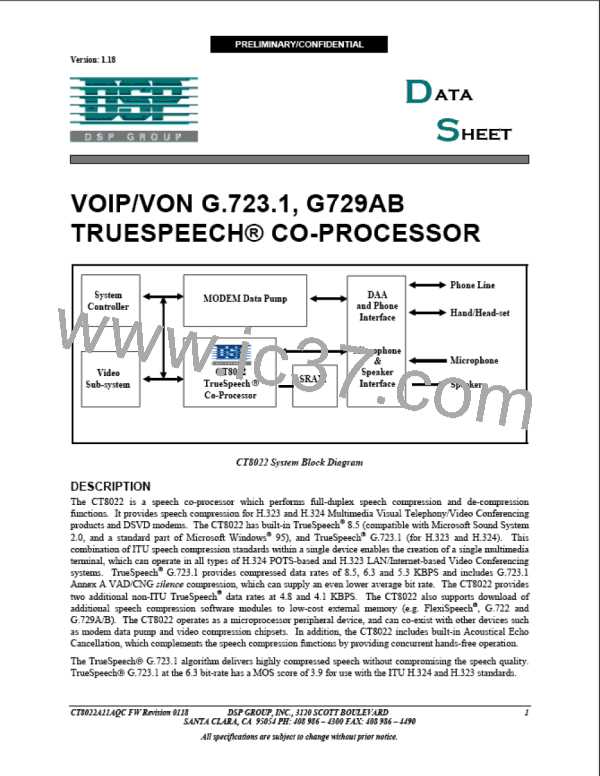TrueSpeech® Co-Processor
PRELIMINARY/CONFIDENTIAL
Version: 1.18
B AEC Performance In DSVD Applications
The CT8022 operates the same AEC algorithm in DSVD mode as Speakerphone mode. Since the AEC canceller
operates on the input signal from the microphone, the effect of the AEC is heard at the far-end, as opposed to near-
end of the DSVD communication link. The echo path in a symmetrical CT8022 implementation is shown below:
The performance of the AEC at this end of the link
affects the user at the other end of the link.
TrueSpeech
Decompression
TrueSpeech
Compression
Microphone
Speaker
AEC
AEC
Speaker
CT8022
TrueSpeech
Compression
CT8022
TrueSpeech
Decompression
Microphone
Figure B-1:
CT8022s Connected via a Digital Link
Under ideal conditions, the AEC can achieve around 34dB of echo attenuation. With a symmetrical arrangement as
shown above, this can produce up to 68dB of loop (or round-trip) attenuation. This is more than sufficient to ensure
that acoustic feedback, howling or howl-round does not occur. However, the audible echo (attenuated by up to 34dB)
may be overly annoying to users, due to the significant delay that is often present in this type of configuration. The
key problem in this environment is the size of the delay, which may be several hundred milliseconds.
When the AEC is active in speakerphone mode, the primary consideration is to prevent howling. This condition is
met, when the total loop gain in the system is less than 1.0. The round-trip delay in this mode is very short. With a
short delay, the human ear is not able to perceive an echo with 34dB of attenuation except as a minor reverberation
sound effect.
When the AEC is active in DSVD mode, since the delay is much greater, the perceptual response to the same level
echo is much greater. The effect of a user hearing their own words echoed back to them with a 300-500ms delay is
very distracting, even with 34dB of attenuation. To overcome this problem, it is necessary to introduce additional
attenuation into the loop. To this end, it is recommended that the AEC be operated with at least 12dB of loop
attenuation. While this precludes the possibility of operating in true full-duplex DSVD speakerphone mode, the
additional 12dB of attenuation enable the CT8022 to achieve near full-duplex operation.
In this mode, the CT8022 monitors the receive and transmit directions in order to decide which direction is talking.
It then attenuates the opposite direction by the selected amount of loop attenuation. The loop attenuation setting is
programmable by the Host in 4dB increments from 0 to 28dB. The active switching of attenuation between the two
speech directions is usually not noticeable to the user. The near full-duplex performance of the CT8022 in this mode
still provides superior performance to comparable systems operating in half-duplex mode, where, at any time, one
speech direction is completely muted. Also note that, without the active AEC in the illustrated situation, howling is
extremely likely to occur, making the speech link unusable.
The CT8022 may be operated in DSVD mode without the AEC if a handset is used in place of a speaker-microphone
arrangement.
184
DSP GROUP, INC., 3120 SCOTT BOULEVARD CT8022A11AQC FW Revision 0118
SANTA CLARA, CA 95054 PH: 408 986 – 4300 FAX: 408 986 – 4490
All specifications are subject to change without prior notice.

 ETC [ ETC ]
ETC [ ETC ]